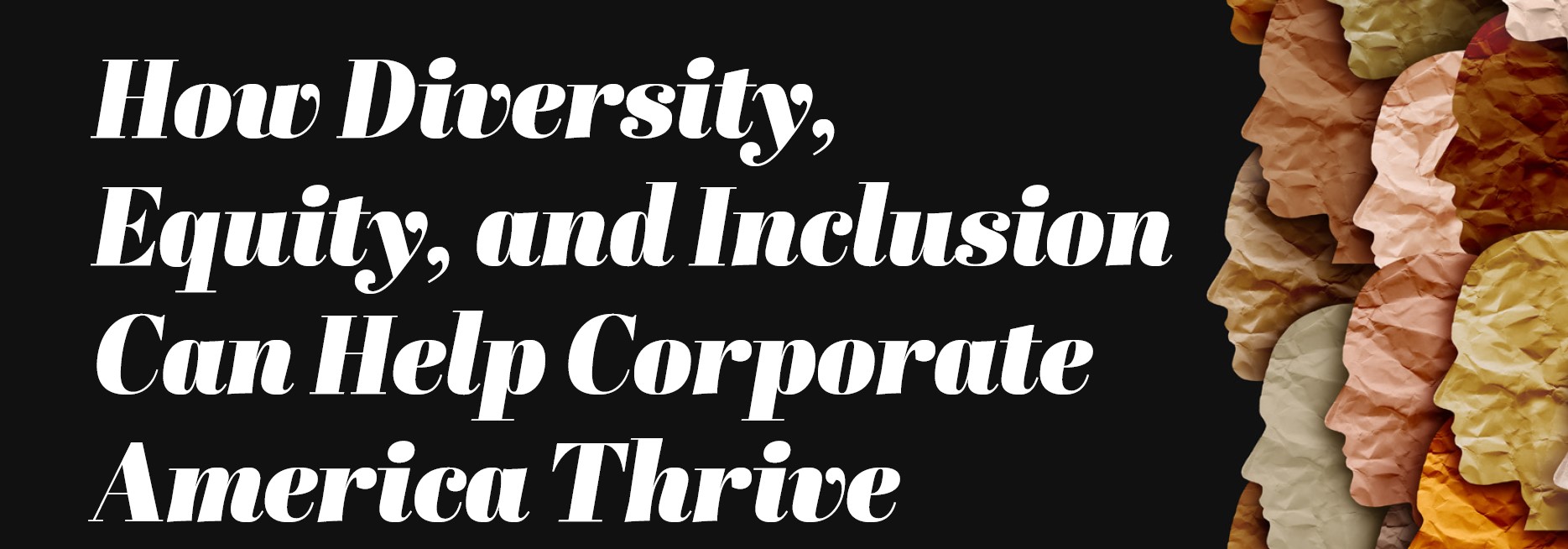How Diversity, Equity, and Inclusion Can Help Corporate America Thrive – Q2 2022 Facts & Findings

Diversity is a simple term that refers to differences. These human differences are a beautiful thing, and as we understand what these differences are we can gain a better understanding of others’ backgrounds. This idea of understanding and accepting how someone of a different background’s unique story shapes how they see the world is a new concept in corporate America. For the
last 50 years, minorities have sought to find their place in the business world. Beliefs were entrenched. The lack of diversity in corporate America wasn’t questioned. As companies are challenged to hire in a way that reflects society, the makeup of the workforce has changed from a white, male-dominated culture to something that is slowly starting to look a little bit more like the makeup of
America. This is a great thing for businesses, and yet this has not been a natural and organic movement.
Inclusion speaks to bringing workers of different backgrounds into the workplace. The 1964 Civil Rights Act made discrimination based on race, color, religion, sex, and national origin illegal. Fairness in hiring practices has been a factor that has accelerated diversity in business. The culture of many companies did not change as people of different races, ethnicities, and sexes saw increased numbers. Management held on to views that had been passed on from decade to decade. These views included prejudices and biases about how people who looked different from the management team would perform. Management changed very little as the workplace changed. White males continued to dominate the roles of management as minorities moved into the workplace.
More companies are embracing the changing of corporate America and are starting to celebrate the fact that they can benefit from differences in background and opinions. As opposed to making it only about race, ethnicity, age, sexual orientation, religious affiliation, socioeconomic status, or some other indicator, they should be focusing on performance. Diversity conversations need to be
examined as they arise so that individuals can engage each other to have a better understanding of how these indicators make us unique. This is what needs to be celebrated and embraced. The world contains expansive differences in people. Differences represent opportunities. There is a depth of complexity that our unique experiences bring to corporate America.
Diversity and Inclusion are different things. Diversity is building a team of people from different backgrounds and experiences. Inclusion is a sense of belonging. There can be very diverse teams, but if their mindset is similar, the value of their makeup is lost. The key to building successful teams is striking a balance between the two. No longer can we avoid bringing together people from
different backgrounds and creating a culture that looks like the world. These blended work environments must also give everyone the opportunities to contribute and the sense that they can excel. When we move past societal norms and how they have been ingrained in the culture and begin to accept that there are other points of view, building an inclusive culture becomes easier. It becomes
the norm for our businesses. We can all learn from each other. This approach to diversity can be exciting to everyone involved.
Studies consistently show that diverse teams add value to companies and improve their performance. Diversity drives creativity and innovation. Diverse teams can take a company to the next level. Taking in aspects of different cultures can help us with product marketing and with market expansion. Customers are drawn to organizations and companies that take the time to embrace them and offer products that reflect their backgrounds. Varied backgrounds can lead to more effective problem-solving. Inclusion can be as simple as having team members of different ages. The variety in knowledge can provide an understanding of how our customers may be thinking. Other elements of diversity can be personality and educational background diversity. Studying how people in
these different sectors interact will also help improve the environment of inclusion in the workplace. Statements and language to increase inclusion can cultivate these shifts in our corporate culture. We can build relationships that encourage involvement. We have to see people for who they are as we build these relationships, by allowing time and opportunity for different ideas and practices to be shared across our companies. Acknowledging differences can also highlight the ways that we can see that we also have inherently human commonalities. We don’t have to be consumed with the fact that there are differences as we move towards this more inclusive culture. We do have to understand that our biases must be examined as they arise. This is called being culturally sensitive. Initiatives that use this as a center of change are easier to implement as they grow along with different aspects of inclusion.
Moving from inclusion we are now challenging corporate culture even more to ensure that equity is part of the conversation. Equity is the pursuit of balance. We all must make a conscious effort to move past our unconscious biases. Meetings, teams, and departments may be diverse, yet diversity is only one piece of the puzzle. Equity comes from creating a culture that allows all the entities involved to have a feeling that their thoughts and contributions are always welcome and appreciated. Creating equity requires intention and attention. We must be aware of any question that comes to mind regarding the practice of equity. Why are we doing something? Who is this going to affect? Is this a good time to reflect on a change that needs to take place? It takes mindfulness that we must tap into so that it becomes natural to us and our corporate cultures. The first step is creating a sense of awareness that allows us to authentically see each other. That can simply be an acknowledgment of a sense of bias. We should all take responsibility for creating atmospheres of inclusion. Peer-to-peer actions are just as important as corporate actions and initiatives. Corporate actions can be slow and need to be coordinated in great detail in most cases. Actions on the local peer-to-peer level can be immediate and sometimes more impactful. These actions can directly impact our office environments. As we open the conversations within our peer groups a wave of empathy can be fostered. This empathy can help us to understand the backgrounds of others and what it may take for them to navigate the world and instances of exclusion daily. You don’t have to understand what everyone’s gone through, you just have to respect who they are and seek to understand that difference at work because you’ll be better for it. Most of us spend more time at work than we do at home, so being able to interact with other people daily should bring about new and exciting interactions in the workplace that we can share with our families at home.
Diversity is how we all show up in the workplace. It is those defining parts of who we are as individuals. It can be who we are in our family. Are you a mother? Are you a father? Are you the middle child? What is your religious background? How do you identify? Do you live in the city or the suburbs? Diversity will always be around us. We all use a process of categorizing things to understand
them. It takes us retraining those thought processes to have new and open states of awareness that look past the categories that we know and use today. This tool of categorization has impacted the workforce for decades. We must educate those peers who see inclusion as a threatening wave of exclusion. We can give a nod to how companies became great without diversity and blaze new trails to companies evolving into greater companies. Corporate cultures must move to a place that seeks to understand fully. Corporate America must also fairly and equally embrace culture shifts. We need to give a platform to the quiet voices in the room. Those voices may offer the next big idea. A welcoming workplace creates fairness in every interaction that matters. Creating a sense of belonging can be infectious.
Diversity, equity, and inclusion are all interconnected. They all must be corporate goals. DEI efforts can attract and retain top talent for years to come by just embracing differences. Over the next 50 years, there won’t be a dominant majority in the United States. New employees are drawn to corporate cultures that present this in their mantras. Companies that embrace cultural diversity will
thrive. At the end of the day embracing diversity, equity, and inclusion measures is just good business.
Author Biography:
 Roderick Parker is a Small Business Owner and Business Consultant. Roderick specializes in branding, marketing strategy, and competitive positioning for startups. Mr. Parker graduated from Samford University in Birmingham, Alabama with a B.S. in Public Administration in 1993. He also studied broadband technologies at APT College and received his Master of Business Administration in International Business/Trade Commerce from American InterContinental University in 2016. Roderick has been the COO of Lynette Allan Events since 2000.
Roderick Parker is a Small Business Owner and Business Consultant. Roderick specializes in branding, marketing strategy, and competitive positioning for startups. Mr. Parker graduated from Samford University in Birmingham, Alabama with a B.S. in Public Administration in 1993. He also studied broadband technologies at APT College and received his Master of Business Administration in International Business/Trade Commerce from American InterContinental University in 2016. Roderick has been the COO of Lynette Allan Events since 2000.
www.roderickparker.com


 Categories
Categories